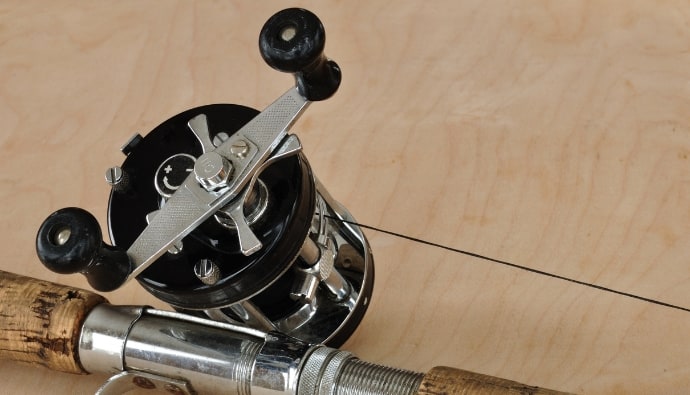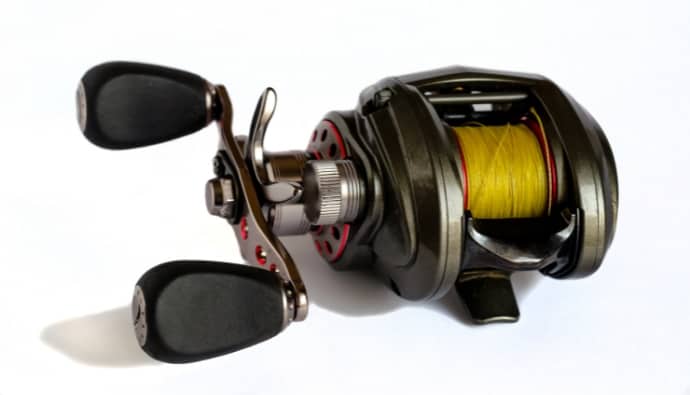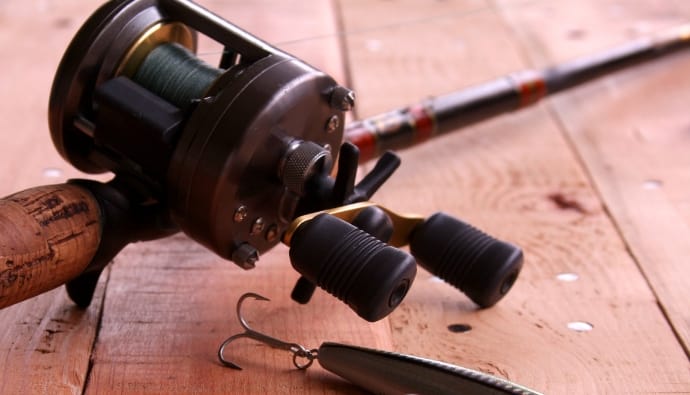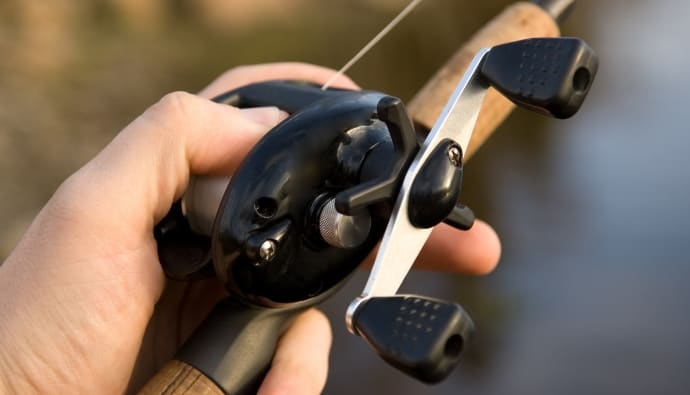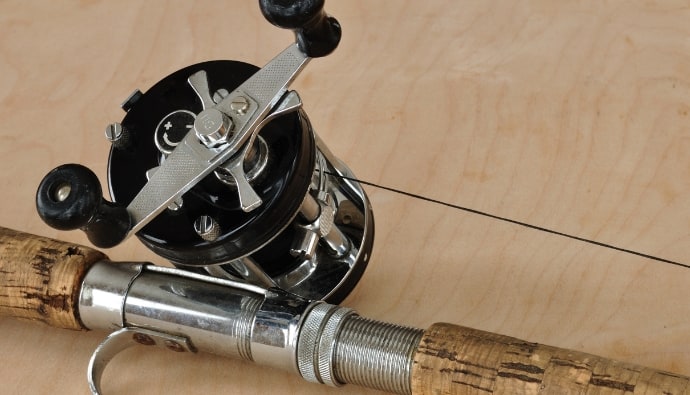Baitcasting and spinning reels are some of the most used reels by anglers, and here are some of their merits. Baitcasting reels generate more power, have longer casting distances, give you greater accuracy, and are an ideal choice for making long-distance casts or targeting specific areas. Spinning reels, on the other hand, are lightweight, easy to use, versatile, and offer you smooth drag. Ultimately, the reel you choose depends on your preference, budget, and needs.
Baitcasters are designed for greater accuracy, longer casting distance, and improved control over your lure and fish. But they can be challenging to use, especially for beginners.
Spinning reels are easier to cast but not as precise. However, their light weight makes them a favorite among beginners looking to save money on equipment.
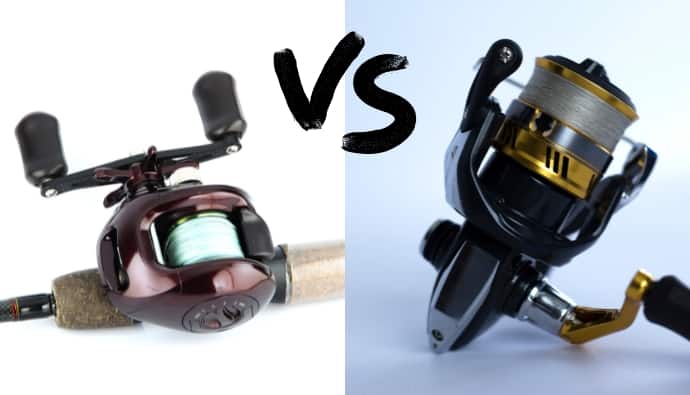
Baitcasting Reels
Baitcasting reels have a spool that rotates as the handle is turned. This allows experienced anglers to cast the line with precision and control.
The reel itself is mounted on top of the baitcasting rod and features a thumb bar or other type of release mechanism. In conjunction with centrifugal or magnetic brakes, they enable the angler to control the speed of the spool during the cast.
A powerful drag system regulates the resistance the fish feels when it pulls on the line. This system helps fight the fish and set the hook.
Baitcasting reels have a higher gear ratio compared to spinning reels. The reel’s spool rotates faster for each turn of the handle, supporting faster retrieval of the line.
These reels are useful for fishing techniques that require fast retrieves, such as flipping and pitching. However, the high gear ratios make a baitcasting reel more challenging to use as it requires more skill to control the spool.
When to Use a Baitcasting Reel
Baitcaster reels are ideal for situations where precision and control are essential, such as when using heavier lines, targeting larger fish species, or casting heavy lures or baits.
Here are some instances when to use a baitcasting reel:
- Bass fishing: Bass anglers favor a casting reel because it allows for the precise casting of heavier lures and baits, such as topwater plugs and jigs.
- Saltwater fishing: A casting reel adequately handles the heavy braided lines often used in these conditions.
- Trolling off a boat: These reels have the power to pull the line through the water at a steady pace.
- When using heavy lines: Baitcasting reels are heavy-duty fishing reels designed for larger and stronger fish. They easily support heavier lines.
Pros of Baitcasting Reels
- Greater accuracy: As the spool rotates during the cast, you have greater control over the direction and distance of the cast, which helps reduce the occurrence of backlashes or bird nests. This makes it a good choice for targeting specific water areas or making long-distance casts.
- Increased power: Most baitcasters have higher gear ratios than other reels. They generate more power when retrieving or fighting fish.
- Better feel: Because the spool is located on the top of the reel, anglers feel the vibrations of the line more easily, which helps detect bites or other changes in the line.
- Larger fish: A casting rod rig is often used for big fish species, such as bass or pike, which require more power and control to catch.
- Handle larger loads: Baitcasters can handle larger lures and baits, which is ideal for catching bigger fish.
- Longer casting distance: The spool rotates during the cast, providing more leverage which allows you to use more of the line.
Cons of Baitcasting Reels
- Learning curve: Baitcasting rods can be difficult to master, as they require a certain amount of skill and experience to operate effectively. This may frustrate and disappoint new anglers, discouraging some people from using them.
- Tendency to the backlash: Tangles easily occur along the fishing line when the spool spins faster than the bait or lure. This causes damage to the reel or rod.
- Heavier weight: These reels are typically heavier than other reels, making them less comfortable to hold and use for long periods.
- Not suitable for all types of fishing: Baitcasting rods are unsuitable for techniques that require more delicate and sensitive reels, such as finesse fishing or fly fishing.
- Higher cost: Baitcasting reels are generally more expensive than spinning reels and spincast reels.
Spinning Reels
A spinning reel attaches to the bottom of a fishing rod. The fishing line is wound around a fixed spool, and the angler casts a spinning tackle by turning the handle, which rotates the spool, effectively releasing the line. To retrieve the line, the handle is cranked in the opposite direction, pulling the line back onto the spool.
When the fish bites, the drag system located at the front of the reel, enables anglers to apply resistance to the spool. This prevents the fish from taking too much line and helps tire out a strong-pulling fish.
Some are fitted with a bail arm that flips over the spool to keep the line in place when casting, preventing line twisting. This enables the angler to cast with one hand and hold the rod with the other.
Spinning reels have a lower gear ratio compared to baitcasting reels. They produce more torque and power to help reel in larger and stronger fish.
Spinning reels are popular among anglers of all skill levels but are the most beginner-friendly due to their simplicity, versatility, and affordable prices. You’ll often see a spinning rod in finesse fishing, light tackle, surf fishing, and in situations where a delicate presentation is needed.
When to Use a Spinning Reel
A spinning reel is a highly versatile fishing reel applied in various fishing conditions. It is well-suited for casting and retrieving very light lures, baits, or flies.
Spinning reel pros recommend spinner rigs for freshwater or saltwater fishing techniques, such as trolling, jigging, and casting in open water or near structures like docks. The spinning reel mechanism allows for more finesse, making it a popular choice for species such as bass, panfish, trout, and catfish.
Pros of Spinning Reels
- Easy to use: A spinning reel is simple to operate, making it easy to cast spinning tackle, even for novice anglers.
- Versatile: Spinners are suitable for various fishing conditions and can catch many fish species.
- Lightweight: This makes them easy to handle and comfortable to use for extended periods.
- Smooth Drag: Spinners have a smooth drag system which allows for controlled fighting against large fish.
- Compatible with multiple lines: You can use monofilament, fluorocarbon, braided, and even hybrid lines on a spinning reel.
- Affordable: Spinning reels are often less expensive than baitcasting reels, making them a cost-effective option for many anglers.
- Widely available: You can find them in any fishing supplies store.
Cons of Spinning Reels
- Less precision: Difficulty in casting accurately compared to baitcasting reels.
- Low power: Most spinning reel models are unsuitable for fighting large or strong fish due to their low gear ratio.
- Less durability: A spinning rod is highly susceptible to wear and tear due to its large number of moving parts and may require more maintenance.
- Higher risk of tangling: Line twist occurs more easily when using thinner spinning reel lines.
Comparison of Baitcasting Reels and Spinning Reels
When choosing between a baitcasting vs spinning reel, the right reel type is determined by a couple of factors. To help you decide, let’s take a look at a brief comparison between the two:
1. Suitability for Different Fishing Techniques and Species
Baitcasting reels and spinning reels are both popular fishing reels, but they are designed for different fishing techniques and species.
Baitcasting Rods
Baitcaster reels are mounted on top of the rod and have a spool that rests perpendicular to the rod. The spool spins as the reel handle is turned, allowing the angler to control the amount of line released.
Casting reels have a high line capacity and are typically used to handle heavier fishing lines, support heavier lures or baits, and for making long-distance, precision casts. This makes them most suited for offshore fishing and techniques that rely on accuracy and control, such as flipping, pitching, and casting.
A baitcaster requires skill to use and adjust, making them a preferred pick for more experienced anglers who’ve mastered the technique of casting and adjusting the reel’s drag.
A baitcasting reel is excellent for making long-distance, precision casts, going after larger, stronger fish species like bass, pike, and muskie, and fishing in heavy cover.
Spinning Rods
Spinning reels, on the other hand, are mounted below the rod and have a fixed spool that is parallel to the rod. The line is released as the spool spins, and the angler manages the speed of the line release by using their index finger.
A spinning reel is extremely versatile and easier to use, making it a good choice for beginners and experienced anglers alike. It is designed for light tackle fishing and casting with light lines and lighter lures or baits for a wide variety of fish, from panfish to salmon.
Spinning models are easier to use and less prone to bird nests, so they are a good option for beginner anglers or those after a more relaxed fishing experience. They are suitable in various conditions, including freshwater and saltwater, as well as for finesse tactics such as drop-shotting and light jigging.
2. Price and Availability
A baitcasting reel is generally more expensive than a spinning reel. A high-end model will set you back several hundred dollars, while more budget-friendly options are available in the $50-$150 range.
Spinners rig setups are readily available in most fishing equipment and sporting goods stores, as well as online retailers. There’s a vast variety of models and brands to choose from for a wide range of price points.
3. Ease of Use and Maintenance
A baitcasting vs spinning reel requires more maintenance for optimal performance. This includes regular cleaning (you have to learn how to clean a spinning reel properly), lubrication, and adjustments like setting the spool tension and adjusting the brake system to ensure smooth operation and longevity.
On the other hand, a spinning reel is considered relatively easy to clean and maintain. Most models require only occasional lubrication.
Conclusion
When it comes to baitcaster vs spinning reel, the prior is sturdier and more powerful but requires finesse and practice to master. On the other hand, a spinning reel offers freedom of line movement and is easier to use, especially for people who are just starting.
The best reel for you depends on your personal fishing needs and preferences. Both are capable of providing quality fishing experiences. The next time you go bass fishing, we recommend trying out both baitcasting and spinning reels to see which you prefer.




 Facebook
Facebook YouTube
YouTube